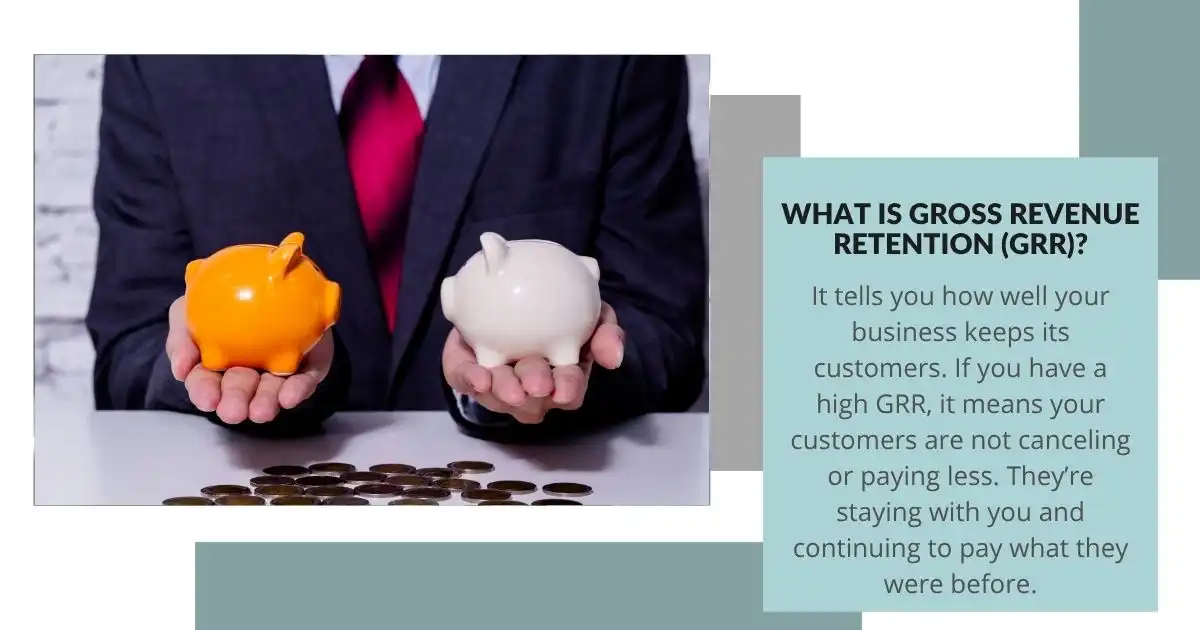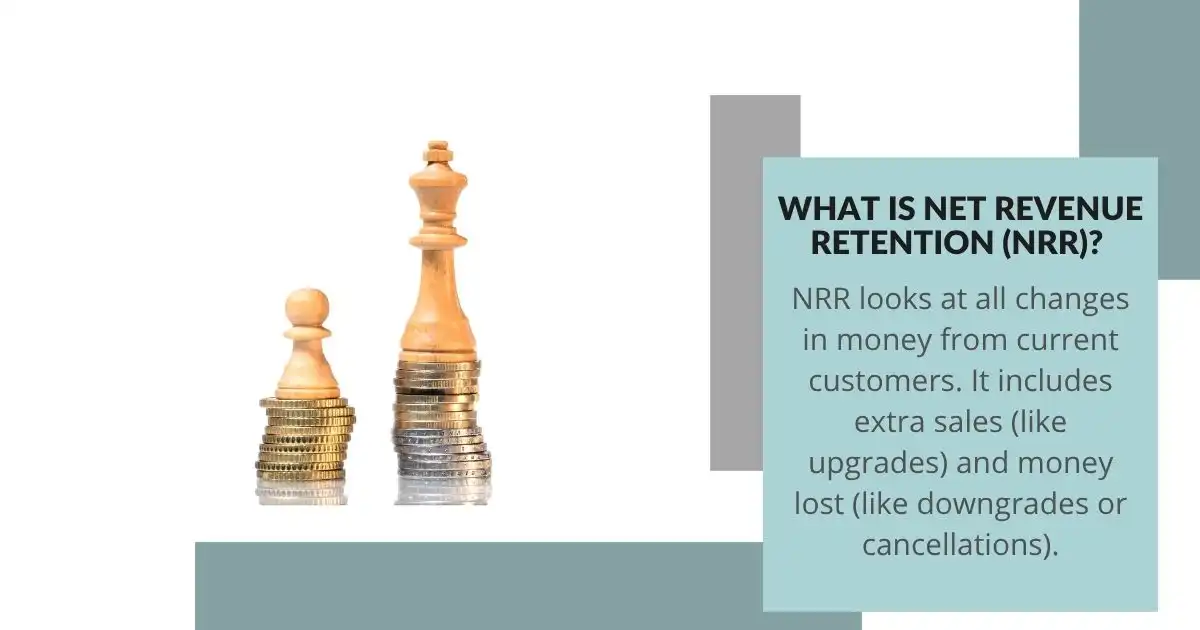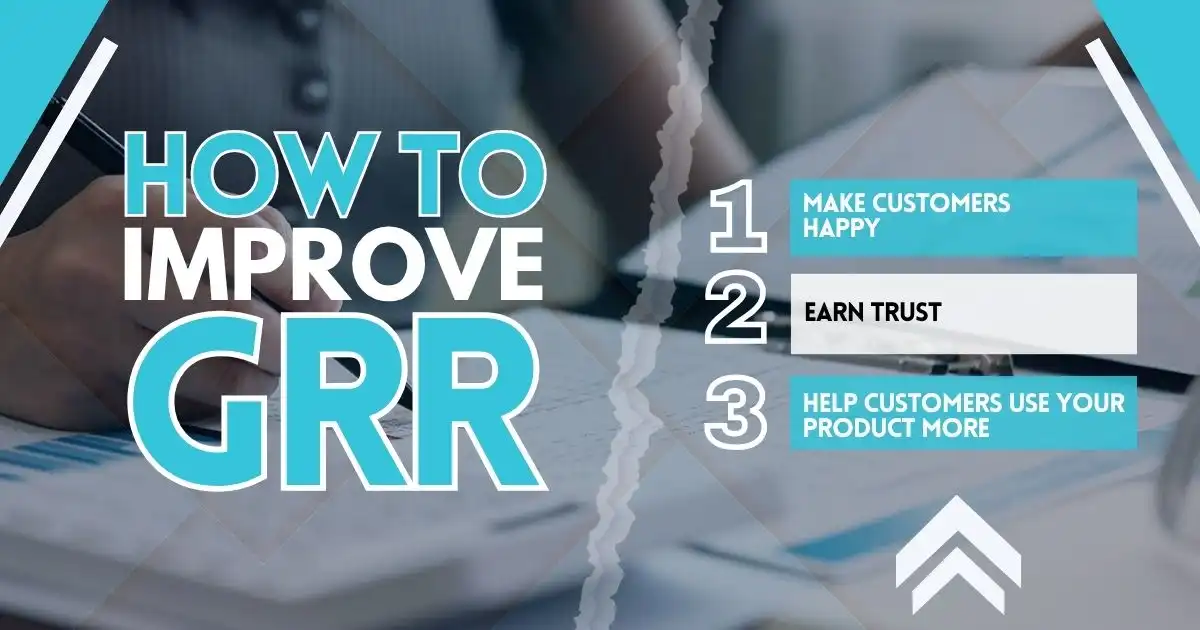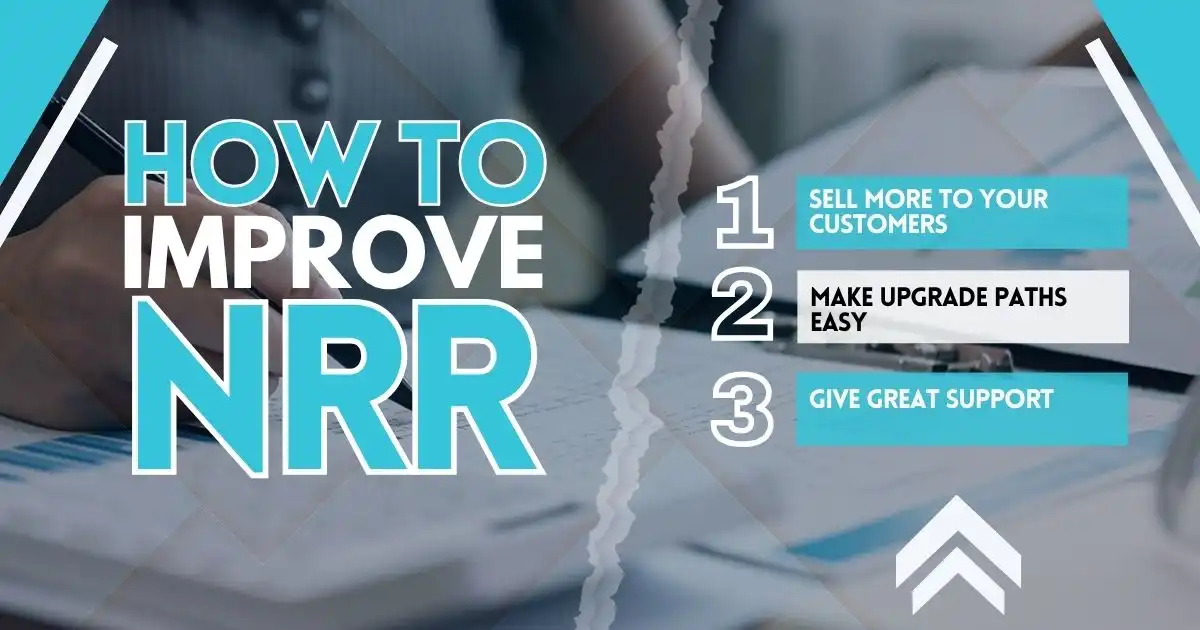Trying to understand how your revenue sticks or grows? Focus on GRR and NRR. These two metrics tell you what’s really happening with your current customers.
GRR tracks how much money you hold onto—no upgrades, no extras, just what you started with. NRR adds it all in—upsells, downgrades, and cancellations—giving you a full view of growth or loss.
Know the difference, and you’ll know exactly where your business stands. Are you measuring momentum, or just standing still?
Understanding Revenue Retention
Your business needs money to keep running. If you can’t keep most of the money coming in from your current customers, it will be hard to grow or even stay stable.
Revenue retention tells you how much money your business keeps from current customers during a set time.
There are two main types:
- Gross Revenue Retention (GRR)
- Net Revenue Retention (NRR)
What is Gross Revenue Retention (GRR)?

GRR is the percentage of money you keep from current customers, not counting any extra sales to them.
It tells you how well your business keeps its customers. If you have a high GRR, it means your customers are not canceling or paying less. They’re staying with you and continuing to pay what they were before.
A high GRR means your business is steady. You don’t have to rely on getting new customers or selling more to the same ones just to stay at the same level.
GRR Formula
GRR = (Starting Revenue − Lost Revenue from Cancellations and Downgrades) ÷ Starting Revenue × 100
Steps to Calculate GRR
- Find the starting revenue – This is how much money you made from your existing customers at the start of the period. Don’t include new customers or extra sales.
- Figure out how much revenue you lost – Add up all the money lost because of customers canceling or choosing cheaper plans.
- Subtract the lost revenue from the starting amount.
- Divide the remaining revenue by the starting revenue.
- Multiply by 100 to get the percentage.
Example:
- Starting revenue: $1,000,000
- Lost revenue: $50,000
- Remaining revenue: $950,000
GRR = (950,000 ÷ 1,000,000) × 100 = 95%
This means you kept 95% of the money from your existing customers.
What is a Good GRR?
Most companies want at least 90%, but this depends on the kind of business you have.
What is Net Revenue Retention (NRR)?

NRR looks at all changes in money from current customers. It includes extra sales (like upgrades) and money lost (like downgrades or cancellations).
It tells you if you’re getting more money from your current customers over time.
NRR Formula
NRR = (Starting Revenue + Extra Sales − Lost Revenue − Downgrades) ÷ Starting Revenue × 100
Steps to Calculate NRR
- Find the starting revenue from current customers.
- Add the extra money made from upgrades or other add-ons.
- Subtract the money lost from cancellations and downgrades.
- Divide by the starting revenue.
- Multiply by 100 to get the percentage.
Example:
- Starting revenue: $1,000,000
- Extra sales: $200,000
- Lost revenue: $50,000
- Downgrades: $25,000
- Final: (1,000,000 + 200,000 − 50,000 − 25,000) ÷ 1,000,000 = 112.5%
So, your revenue went up by 12.5% with your current customers.
What is a Good NRR?
It depends on your business, but higher is better. Over 100% means growth. Below 100% means you’re losing money from your current customers.
Why Revenue Retention Matters
It costs significantly more to acquire a new customer than to retain an existing one—studies estimate it’s about four to five times more expensive. That’s why revenue retention is a critical metric for any subscription-based or recurring revenue business.
Strong revenue retention means your customers continue to see value in your product or service, leading to more predictable and stable income streams. Gross Revenue Retention(GRR) measures how well you retain existing revenue without considering expansion, while Net Revenue Retention (NRR) goes a step further by including upsells, cross-sells, and upgrades. Together, these metrics reveal whether your business is simply maintaining its customer base or growing within it.
High GRR indicates customer satisfaction and low churn, while high NRR shows that not only are customers staying, they’re spending more. Focusing on improving revenue retention leads to higher customer lifetime value, stronger margins, and sustainable long-term growth.
When to Use GRR or NRR
Both are helpful, but they tell you different things.
- GRR shows how well you’re holding on to your customers without counting upgrades or new sales.
- NRR shows if your current customers are spending more with you over time.
You can look at both to get a full picture of how your revenue is changing.
How to Improve GRR

To keep more of your customers:
- Make customers happy – Ask for feedback and fix problems.
- Earn trust – Keep your promises and give great service.
- Help customers use your product more – Give training and support.
How to Improve NRR

To grow with your current customers:
- Sell more to your customers – Offer helpful upgrades or related products.
- Make upgrade paths easy – Help customers move to better plans that suit them.
- Give great support – Happy customers are more open to buying more from you.
3 Common Mistakes to Avoid

- Not listening to customers – You miss chances to improve if you don’t know what went wrong.
- Ignoring small customer groups -These groups might be your most loyal.
- Not keeping up with changes – Your plans should change as the market changes.
Industry Examples
Different types of businesses need different ways to keep customers:
- Manufacturing – Offer services after the sale to keep customers.
- Real Estate – Build strong relationships with tenants.
- SaaS -Make flexible plans so customers stay longer.
- Retail – Use loyalty programs to encourage repeat shopping.
Take Charge of Your Revenue with Smart Retention Moves
Revenue retention is more than just keeping money—it’s about keeping trust, building stronger relationships, and making sure your business doesn’t have to start over every month. When you focus on keeping the customers you already have, you create a steady path for growth.
Use GRR to understand how well you’re holding on to your income, and use NRR to see how much more your current customers are willing to invest in you. These numbers are not just for reports—they are signals. They show you where to act, where to improve, and where you’re already doing well.
If you’re not paying attention to retention, you’re working harder than you need to. Keeping a customer is far less costly than getting a new one. And every small effort—fixing a problem, offering help, or providing real value—can make a big difference.
Start now. Make every customer count. Let your retention strategy be your advantage in building a business that lasts.
FAQs
What is GRR, and how is it used?
GRR (Gross Revenue Retention) is a metric that shows how much recurring revenue you keep from existing customers, excluding any expansion or upsells. It reflects customer retention and the impact of churn or downgrades on your revenue base.
What is NRR, and why does it matter?
NRR (Net Revenue Retention) measures how much recurring revenue you retain from existing customers, including expansion revenue like upgrades or cross-sells. A high NRR means your customer base is not only staying but spending more over time, which signals healthy growth.
What’s the difference between GRR and NRR?
GRR focuses solely on retention by excluding any revenue from upsells, while NRR includes expansion revenue. Comparing both gives insight into how well you’re keeping customers (GRR) and how effectively you’re growing revenue from them (NRR).
What is a good NRR benchmark?
A good NRR depends on your industry, but generally, 100% or more is considered strong. For SaaS and B2B companies, an NRR of 120% or higher is often a sign of excellent customer retention and revenue expansion.
